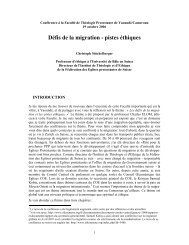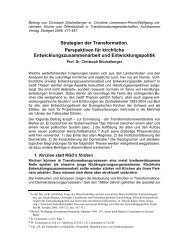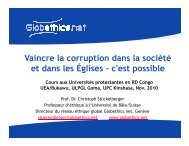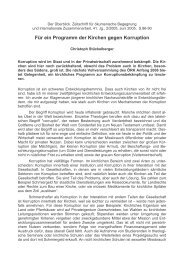BREAK THE CHAINS OF OPPRESION AND THE YOKE OF ...
BREAK THE CHAINS OF OPPRESION AND THE YOKE OF ...
BREAK THE CHAINS OF OPPRESION AND THE YOKE OF ...
You also want an ePaper? Increase the reach of your titles
YUMPU automatically turns print PDFs into web optimized ePapers that Google loves.
FuturE Reflection 11<br />
“A commitment to living within sustainable levels of carbon emissions is<br />
central to Christian discipleship in our days.”<br />
● How far do you agree with this?<br />
● What, in your understanding, are “sustainable levels of carbon emissions”?<br />
How could this be realistically achieved in your daily life?<br />
Reducing the carbon footprint of the church<br />
As churches, we must address the carbon footprint of our own activities. We<br />
must first move quickly to discover the current level of our carbon emissions and<br />
identify a strategy to enable an audit of carbon emissions at all levels of the<br />
church, so that local churches, regional structures, and national church institutions<br />
become aware of the starting point for action to reduce carbon emissions.<br />
Alongside this we must establish a way of supporting church structures at all levels<br />
in making reductions in carbon emissions proportionate to the overall reductions<br />
necessary by 2050 of at least 80%, with the urgent and immediate interim<br />
steps this requires. National churches will need to provide support and incentives<br />
for local and regional structures to meet this challenge. We do not underestimate<br />
the magnitude of this task but consider it the minimum adequate response<br />
to the situation we face, as well as the only morally authentic basis for<br />
calling on church members and the nation at large to make similar changes. We<br />
recognize the structural factors, internal and external to the churches, that impede<br />
progress towards these goals, and the need for churches to work in partnership<br />
with local and national government to overcome the barriers to change.<br />
Church policy in �many �areas, �including the investment � � of church funds, will<br />
need to be reviewed in the light of this commitment.<br />
Helping members of congregations to reduce emissions<br />
Alongside actions to address the carbon emissions associated with the corporate<br />
life of our churches, we need to identify ways of enabling members of congregations<br />
to make changes in their carbon footprint matching the minimum<br />
of an 80% reduction target together with appropriate interim goals. Again, the<br />
first task is to encourage and facilitate an audit of current carbon emissions,<br />
followed by supporting individuals in church or small group contexts to commit<br />
to reducing their carbon footprint and identifying strategies to do so. We<br />
believe that many will respond to the offer of exchanging a general consciousness<br />
of guilt for addressing the topic responsibly and realistically in a group<br />
context. The early church began as a movement of small groups of Christians<br />
who agreed to be accountable to one another. It may be that, if we can recover<br />
this sense of accountability which small groups can foster, many may be enabled<br />
to make changes that seemed impossible in isolation. If congregations<br />
��������������������������������������������<br />
� � � � ��������������������<br />
�<br />
– HOPE IN GOD’S FUTURE – 165










